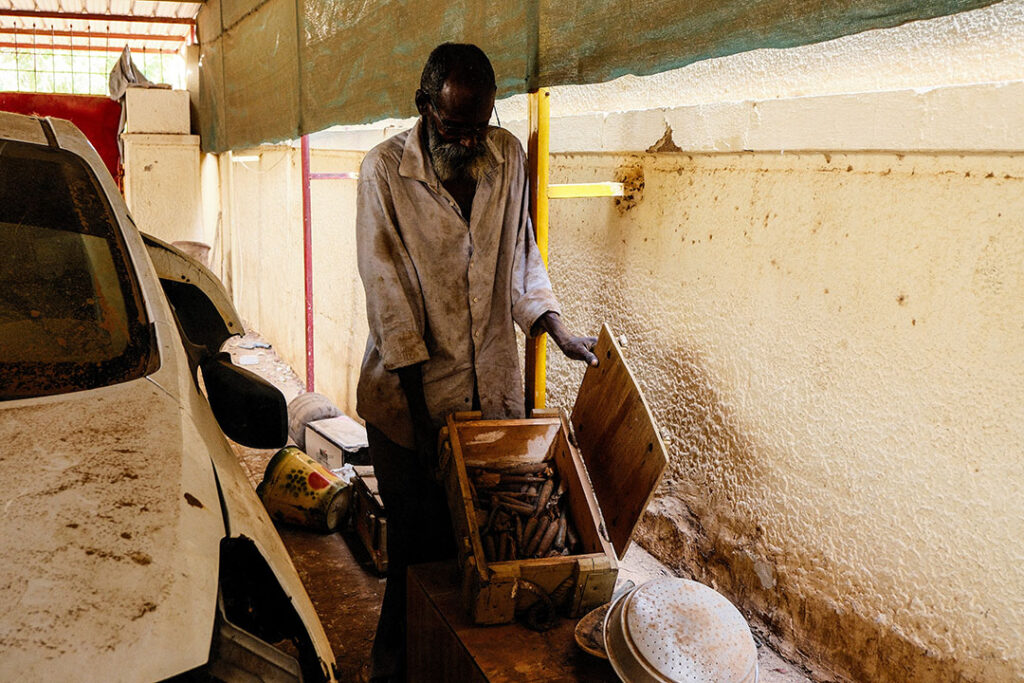Shock and frustration colored Abdelaziz Ali’s face as he walked out of the primary school where he worked in Khartoum. Like so much of Sudan’s capital, the school was littered with the wreckage of war.
He emerged from one of the buildings with an unused artillery shell that he found under a pile of cloths.
“How wouldn’t I be afraid?” he told Reuters news service. “Every day I find two containers filled with ammunition and [rocket-propelled grenades] and other explosives, all in here, a children’s school. All of these things need to be cleared.”
Sudan’s civil war has played out largely in cities and towns — densely populated areas where civilians lived and worked before many fled. By the end of 2024, more than 14 million people were displaced, representing nearly one-third of the country’s population, according to the United Nations.
“Thousands of schools are in the war zones … mosques where people are going five times a day … hospitals, clinics, roads. … The situation is very, very risky,” Mohammad Sediq Rashid, chief of the U.N. Mine Action Service (UNMAS) in Sudan, told Anadolu news agency.
“Weapons that produce huge amounts of dangerous unexploded ordnance were used. People returning to their areas … will find unexploded ordnance in their homes, on their rooftops, stuck in the walls.”
In more than two years of fighting, members of the paramilitary Rapid Support Forces (RSF), armed with artillery and anti-aircraft weaponry, have spread throughout populated areas. Sudanese Armed Forces (SAF) fighter planes and attack helicopters have launched missiles and dropped bombs.
Since the SAF retook Khartoum and Omdurman, twin cities separated by the Nile River, thousands of Sudanese have returned, Ali among them.
So did 16-year-old Moezr Monzir and his family, who returned to their home on Tuti Island between Khartoum and Omdurman and found a 23 mm anti-aircraft round.
“While we were normally cleaning the house … we heard an explosion,” Monzir’s uncle, Al-Noourany Mahmoud, told Reuters. “He was sitting on a chair, and suddenly it exploded without warning.”
Monzir lost his left arm and suffered other severe wounds.
Experts say that when it comes to explosive weapons, civilians overwhelmingly bear the brunt of their use in populated areas. Now that some displaced Sudanese have returned, they face the threat of unexploded ordnance (UXO), land mines, and abandoned munitions scattered across urban and rural neighborhoods.
“The widespread presence of unexploded ordnance is a silent killer in Sudan’s villages, towns and cities,” Clementine Nkweta-Salami, the U.N. resident coordinator and humanitarian coordinator in Sudan, said in an April 3 statement. “Every day that passes without action increases the risk to civilian lives.”
The number of civilians killed and injured by UXO is impossible to ascertain and grossly underestimated because much of Sudan still is engaged in armed conflict, which has decimated the nation’s health care system.
Maj. Gen. Khalid Hamdan, director of the Sudan National Mine Action Center, said that casualties from war debris could be significantly higher in RSF-controlled areas. Communication blackouts limit access there, and civilians often are unable to report incidents or seek medical help.
“Before the war, it was easier to identify and isolate hazardous areas. But now, fighting has engulfed heavily populated regions, making awareness campaigns and citizen reporting essential,” he told Asharq Al-Awsat newspaper.
Hamdan said that more than 49,000 explosive remnants have been destroyed so far, including 37,000 large munitions and 12,000 smaller shells.
Since the war began, UNMAS has delivered explosive ordnance risk education to 246,474 people, conducted awareness briefings to 1,540 aid workers, and provided technical advice on UXO safety in response to requests from various humanitarian actors.
What concerns Rashid is how much of Sudan’s urban population still is unaware of UXO hazards.
“The population of Sudan, especially people living in the urban areas, are largely unaware of the risks of unexploded ordnance,” he said. “We are using direct explosive ordnance risk education, where the trained teams are deployed … and indirect risk education, which involves broadcasting messages through radio. We did this hundreds of times.”
In April, UXO and land mines caused 24 deaths, according to UNMAS.
“In the first month after Jazeera state became accessible, more than 20 casualties were reported from just one city,” Rashid said. “There is a risk that people will return, and as time passes, these explosive hazards will be forgotten, becoming a silent killer.”

